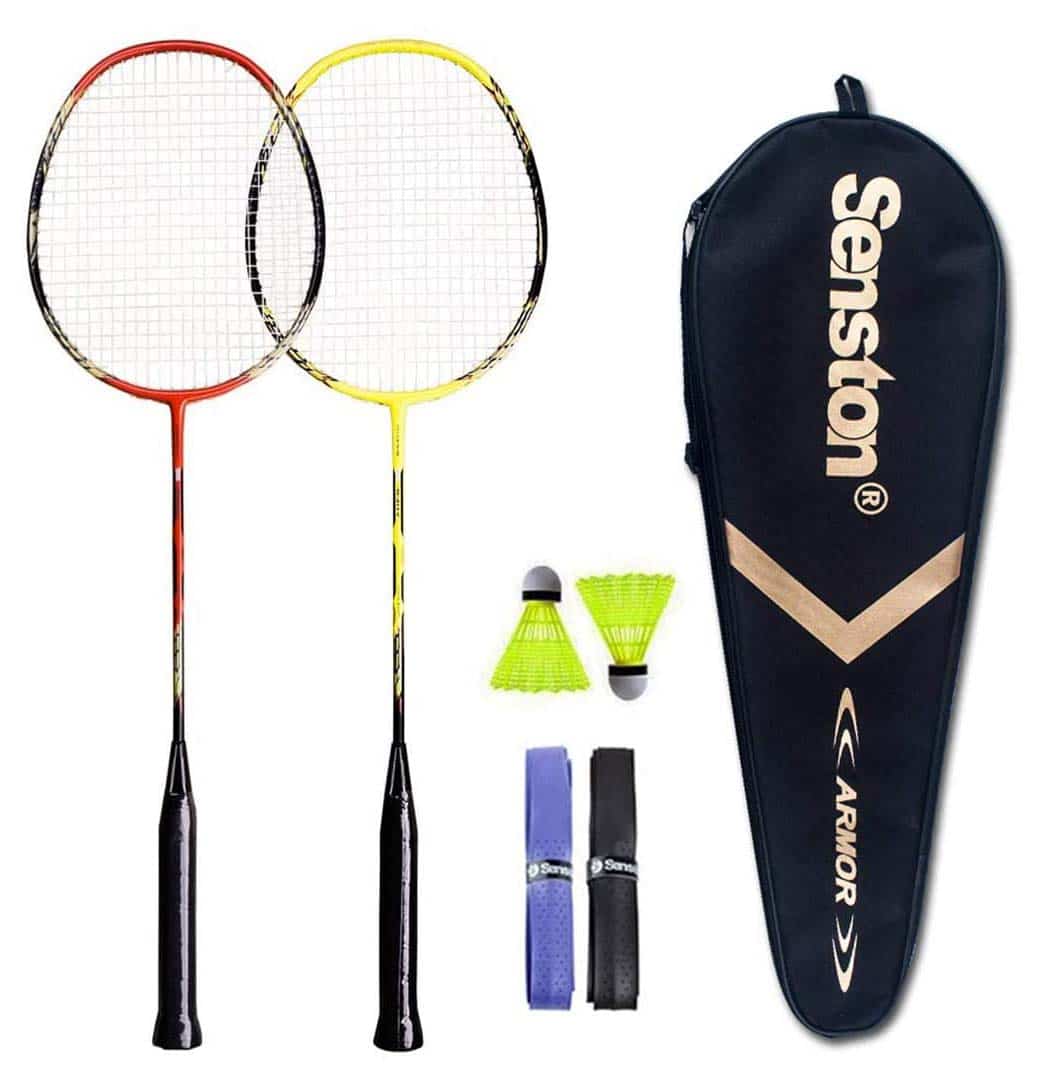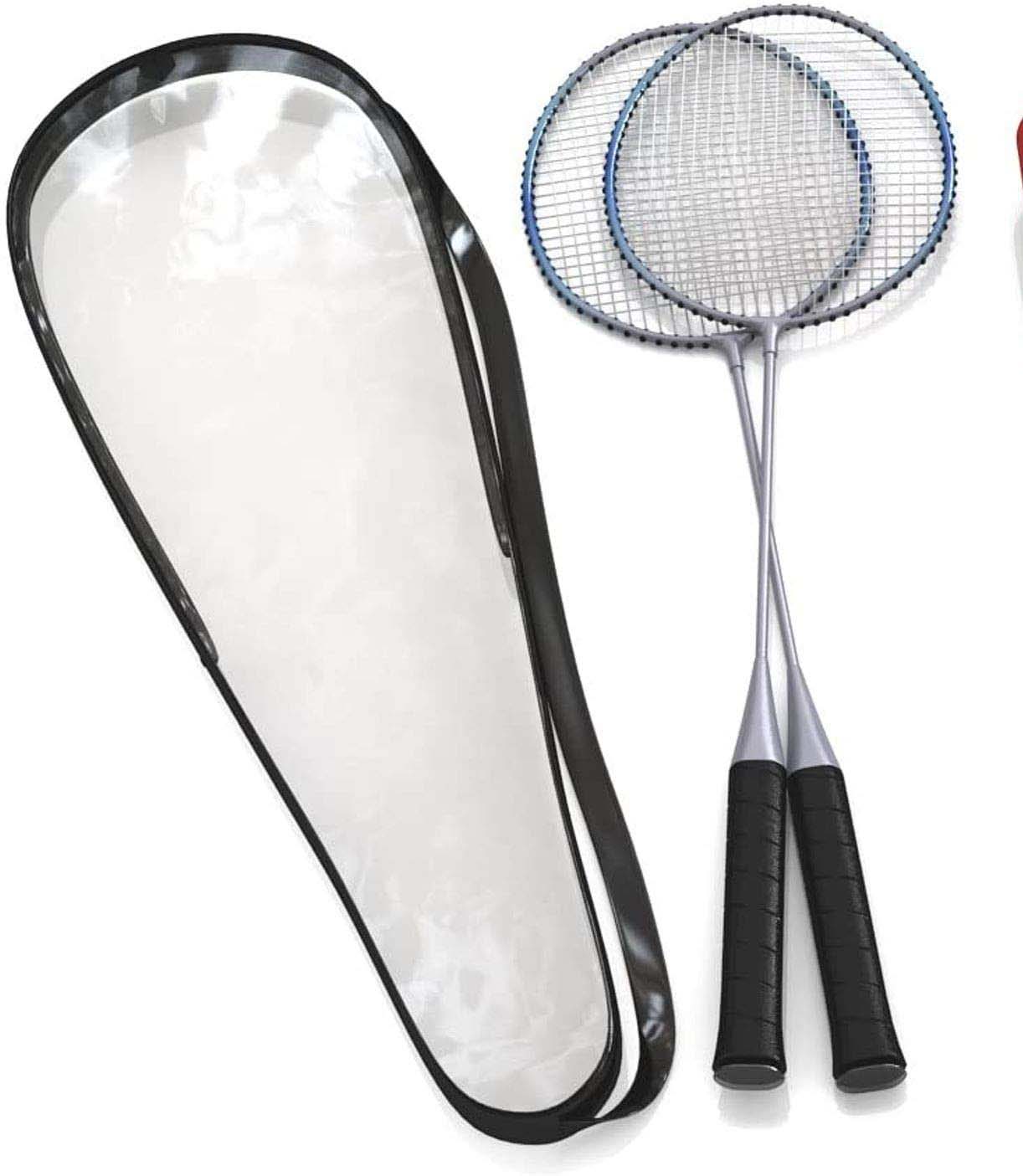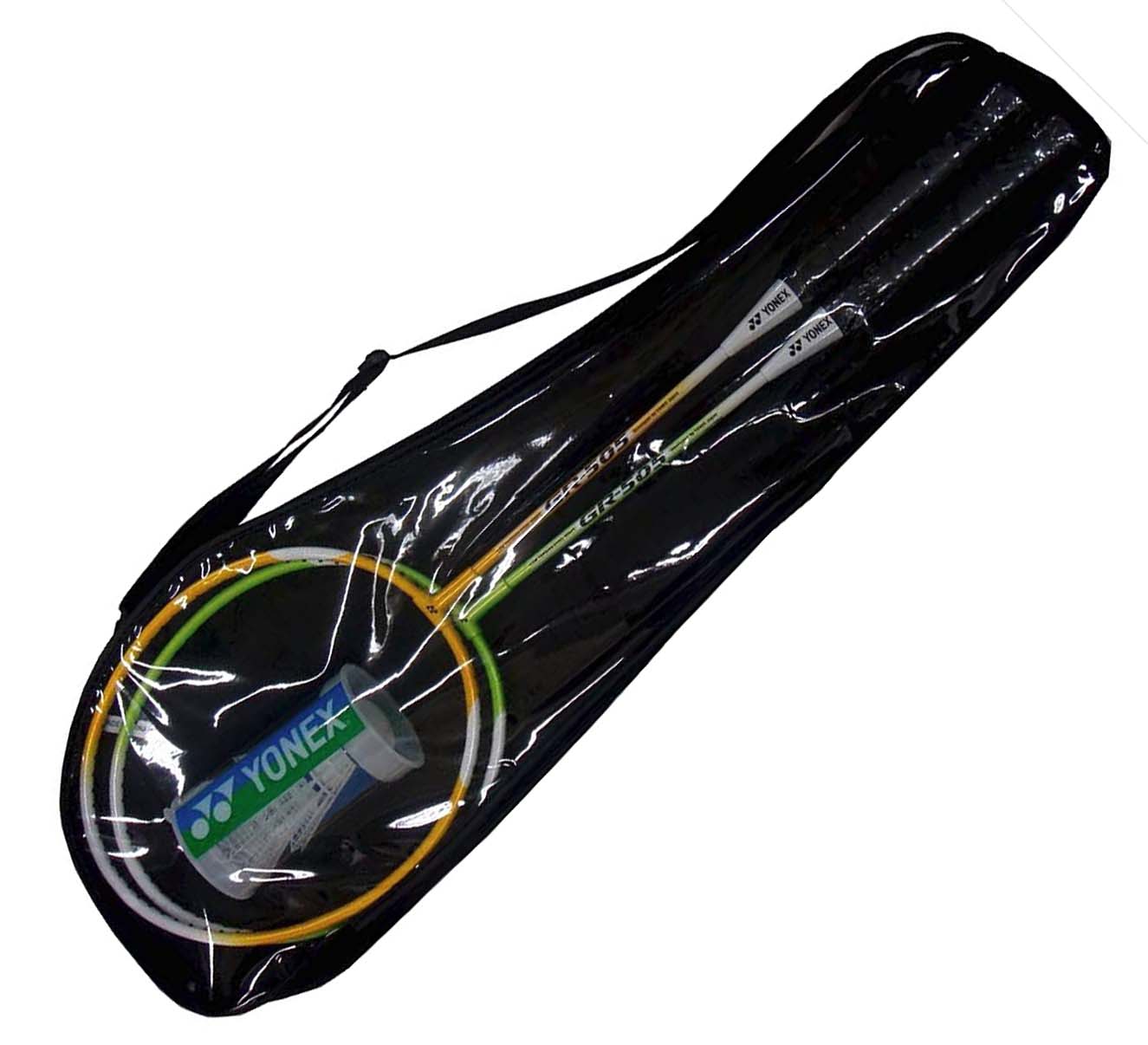There are two types of shuttlecocks used in badminton: feather and plastic. Plastic shuttles are constructed from synthetic nylon, whereas feather shuttles are constructed from goose feathers adhered to a cork foundation.
If you want to play with the plastic shuttlecock, we have listed the best badminton racket for plastic shuttle to make your selection process easier.
Which are the best badminton rackets for plastic shuttle
Last update on 2024-10-09 / Affiliate links / Images from Amazon Product Advertising API
Choosing a badminton racket for a plastic shuttle seems easy until you jump into the market. Numerous brands and models perplex you. To help you out, we have done the homework and present you with the best badminton racket for plastic shuttle.
This package will ensure you can play for a long time without getting wrist or shoulder strain.
The graphite structure provides for effortless play, making them popular. Playing will be both fun and less taxing if you add the over-grip that gives you a softer handle.
The rackets have flexible shafts for powerful strokes with little effort. Due to the flexible shaft's T-joint design, there is no risk of it breaking away from the head.
Despite the racket's low weight, the joint provides strong smashes.
To get started playing badminton, try using this set of rackets. They're easy on the wallet.
I think it's a good value because of its exceptional features. One-piece carbon graphite structure provides an easy-to-handle racket for increased mobility throughout gameplay.
The rackets have stiff shafts and incredibly tight strings to give players a precise and robust serve. When it comes to knocking your opponent out of their position and getting ahead in the game, this will be a huge advantage.
Additionally, the rackets are sturdy, as they are constructed without joints. So you may use the set for a long time.
This package includes rackets that are lightweight and simple to handle. You won't need the experience to use them, because they'll function quite well anyhow.
The flexible slender shaft allows for strong rebounds with little effort. They glide through the air smoothly, owing to their aerodynamic shape.
Your arms won't get tired from holding them because of the clever design. This set also includes 5 LED shuttlecocks so that you can play late at night or in low light.
The OPPUM set includes lightweight, flexible rackets that are perfect for beginners.
Because they are made of carbon fiber, they are lightweight and easy to swing. These rackets let you play longer and feel less tired.
To hit with full force, you don't have to put all your energy into it. The OPPUM rackets are made of 100% carbon fiber, which means they are resistant to wear and breakage.
If you're want a long-lasting, unbreakable racket, then you've come to the right place.
The rackets in the set are constructed of solid steel, which means they endure longer than traditional rackets.
With this racket, you will deliver hard smashes and rebound almost immediately after the shot.
If weight isn't an issue and you're searching for power, pick up the Yonex Combo Set.
Best Badminton Racket For Nylon Shuttle - Buying Guide
A badminton racket include 3 elements: the shaft, the head, and the handle, which also includes the grip. Each component affects the object's handling, accuracy, and shock resistance.. In this sense, it is essential to take these criteria into account and know each component's nature well to choose the best badminton racket for nylon shuttle and not regret your investment.
The weight
A badminton racket's typical weight is 80 to 110 grams, light enough to return a shuttlecock weighing just 5 grams. Playing with a light racquet has the advantage of relieving fatigue and allowing greater endurance during the match. For this reason, I recommend women and children, who play badminton with a plastic shuttle, to choose light rackets around 80 grams or a little less.
Heavier badminton rackets have the benefit of having a larger impact hardness due to the increased mass striking the shuttlecock.. This type of racket, ideally around 90 to 95 grams, is more recommended for intermediate players, for whom the higher weight should not be a problem. Regarding rackets over 100 grams, I do
not recommend the acquisition fiercely because their handling is more complex, which impacts the game negatively.
The cheapest badminton rackets, which cost approximately $ 10, typically weigh between 100 and 110 grams due to their steel construction. While steel is less costly, it is also heavier. I strongly advise against the usage of this type of racket. It is preferable to pay somewhat more on a model that enables progression in the sport.
The framework
As for the frame, the rule is simple: the more rigid it is, the greater the precision will be. In other words, the more flexible the frame, the less precise and quick you will be in your movements.
Badminton rackets with a rigid frame are recommended for experienced players with an excellent hitting technique because the vibrations that spread through the arm at the moment of impact can cause "tennis elbow" in less experienced players.
For this reason, we recommend that beginners choose tennis rackets that have a flexible frame. Experienced players can opt for a racket with a rigid frame which will allow them better precision.
The string
Badminton racket stringing is often a parameter neglected by beginners. However, this is one of the most important criteria to consider when buying a racket since it has a significant influence on the performance of the object.
A racquet stringing may be thick or thin. A thick string will last longer but will offer fewer playing sensations. A thin string will transmit more sensations to touch but will be more fragile. Only experienced players can be able to feel the difference between thick and thin string.
This is why beginners should go for the thick string that will allow them to train and progress without damaging it. Be careful, though, because a thick string, even if it lasts longer, gradually loses its elasticity and must be changed every 2 to 3 months.
Seasoned players will appreciate a fine string that will offer them more sensations. They can also take into account other criteria such as the composition of the sheath, the core of the string, its plasticity, and its roughness which also greatly determine the quality of the racquet.
String tension also influences the quality of play and player performance. The choice of tension, expressed in kilograms, depends on each player, level, and game type. There is no rule to follow because the ideal level of tension varies from one player to another and is determined after several tries.
Usually, the level of string tension increases with progress. A lightly stretched string promotes elasticity and is ideal for beginners (I advise you to start with a tension of around 7-9 kg). In contrast, experienced players with a more incredible arm speed will stretch their racquet more, promoting speed, regularity, and precision of the strike (high-level players use the tension between 13 and 16 kg).
The Shape of the head
There are two shapes of badminton rackets: the classic oval Shape and the isometric Shape. The isometric racquet features a flat oval head on the top. This Shape has the advantage of allowing better homogeneity of the length of the strings over the entire screen and thus increasing the size of the ideal impact zone. The isometric racquet also promotes power but slightly loses precision.
A classic oval racket will do very well for a beginner player or a practice in the context of leisure. Competitors may prefer an isometric shape and thus benefit from the increased size of the point of impact.
Matter
By definition, a badminton racket has to be light and flexible. Made of light metal, there are three badminton rackets: the aluminum racket, the graphite racket, and the half-aluminum, half-graphite racket.
Aluminum rackets are the cheapest. Relatively solid, however, they are not suitable for the professional practice of badminton and are reserved for school children, beginners, and people who practice this sport as an occasional hobby.
I recommend the purchase of an aluminum-graphite racket for club players. They are a little more expensive but of better quality, lighter and very handy.
Graphite racquets are the most expensive and are intended for professional use. High-level players use them for their lightness and optimal performance.
Balancing
The balance of a racquet is one of the other most important parameters to consider when buying. Balance refers to the distribution of weight over the racket frame and is calculated from the neutral balance weight (located in the middle of the shaft) and then measuring the distance from that point to the end of the shaft. Expressed in centimeters or millimeters, the ideal balance depends on each person and the type of game. It influences the handling of the racket, favoring more power or control.
Head balance (where the racquet's weight is greater at the frame) is suitable for offensive play because it promotes punching power. I recommend it for less powerful players who will find it helpful to succeed in reaching the bottom of the course. However, head balancing strains the arm and decreases handling.
The neutral balance represents the ideal compromise between power and handling. It promotes the versatility of movement and is suitable for all levels and all types of play. I recommend this type of racket for doubles games since it allows you to switch from attack to defense without constraint.
Finally, the balance in the handle (greater weight in terms of grip) allows excellent maneuverability and promotes reaction speed. This type of balancing is also less tiring on the arm, the downside being that it does not promote punching power. Rackets that are balanced in the handle are very maneuverable and recommended for defensive players and influential players.
The grip
The grip refers to the lower part of the racquet, also called the shaft. There are several grip sizes available on badminton rackets, from thinner to thicker. The choice of this thickness is critical and should be determined according to the size of your hand.
Most brands of racquets express grip size the same way. The dimensions thus vary from 1 to 3, 3 being the thickest sleeve size. Therefore, women and children prefer grips 1 to 2, while a size 3 corresponds to the most imposing hands. As a general rule, size 2 is suitable for the larger number.
The Yonex brand has a different grip size designation system, divided into four categories from thinner to thicker: G6, G5, G4, and G3. Size G4 is most commonly used, while G5 rackets are generally suitable for children and women.
Feather Shuttlecocks or Nylon Ones – Your Game, Your Choice
Synthetic shuttlecocks are made of plastic or nylon, whereas feather shuttlecocks are made of feathers. The feather shuttlecocks are light, and the plastic shuttlecocks are strong. So, how to solve the problem and choose between the two?
Casual or Competitive?
Your skill level will determine the shuttlecocks you use. Are you a casual badminton player? If you intend to play the game at picnics, you may wish to consider purchasing nylon shuttlecocks. They're perfect for someone learning how to play. If you're playing in a professional match, you need feather shuttlecocks because nylon ones aren't allowed. GE94 Golden Eagle feather badminton shuttlecocks are durable, consistent, fast, and considered one of the best badminton racket for plastic shuttlecock..
Feeling the Flight!
In comparison to feather shuttlecocks, a nylon shuttlecock goes somewhat further. However, the feather shuttle is better for narrow net strokes. Thanks to its design, you can strike a feather shuttle correctly. For example, Yonex Aerosensa 50 feather shuttlecocks are suitable for experienced players.
Cost-wise Calculation
Feather shuttlecocks are perfect for badminton contests. But you must properly care for them. They are also more expensive than nylon shuttlecocks, making replacement more difficult. Choosing the cheaper option is ideal for beginning players. For example, Yonex Mavis 350 and Mavis 2000 nylon shuttlecocks are less expensive and last longer.















Leave a Reply